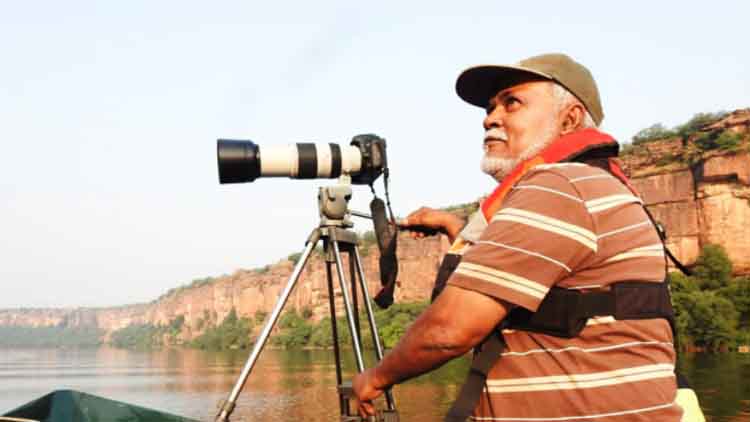
Neelam Gupta/New delhi
After I shifted to Delhi for work, it happened rarely that I was visiting Kota, my native place, and returning without seeing Hanif Zaidi and his lovely wife Razia. Either they came home or I visited theirs'. While I and Razia would be engrossed in a conversation, Zaidi clicked pictures; sometimes we even posed for him. The pictures will be home delivered by Zaidi the next day.
The pictures Zaidi clicked were stunning. The subject looks suffused in happiness.
His pictures of every nook and cranny of the city made everything look so beautiful and magical. The pictures could be of the Hadoti river, the forts, or the migratory birds hopping on the waters of Kishore Sagar lake.
Since 1970 when Zaidi had picked his camera and his pictures got regularly published in newspapers, it often happned that people rushed to the place featured by Zaidi after seeing its pictures. The placed glowed in a new light and people looked at it with a fresh perspective and admiration. For example, Jagat Mandir situated in the center of the town, gained a new image after Zaidi clicked its pictures and the same were published in local newspapers.
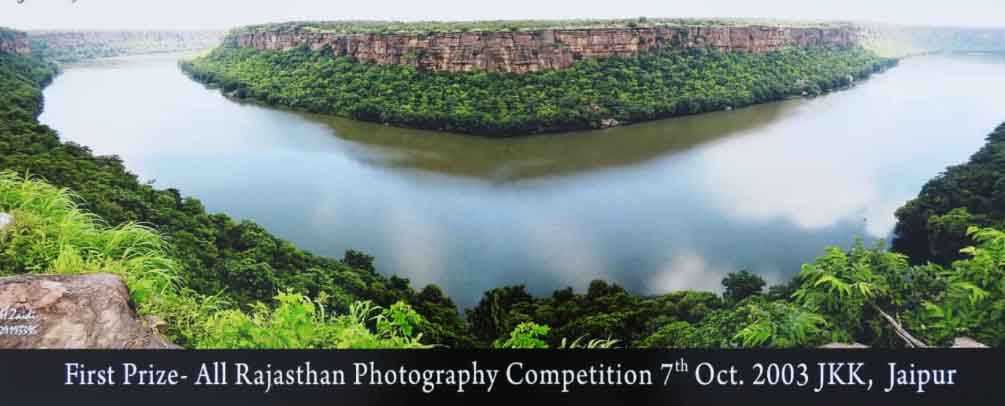
Panaromic view of Gudaria Ji Mahadev, Chambal
No wonder, the picture was so impactful that the Tourism department used it for a campaign to bringing in tourists to this town. He did the same magic with the Gudariaji Mahadev situated on the banks of Chambal.
The people of Kota and Bundi would visit Gudaria temple in Chambal in the rainy season and yet Zaidi’s pictures made it look so different and magical.
According to Sandeep Srivastava, an officer in the Tourism department, “In his picture one could feel Chambal smiling.”
“When I saw that picture, I didn’t believe it was Chambal of Kota; it looked like an island,” Srivastava said. This picture was adjudged the best one in the competition held by Rajasthan Tourism in 2003 and Zaida was awarded.
The above two cases are just a small example of the magical work of Abdul Hanif Zaida who completed 50 years of his professional journey.
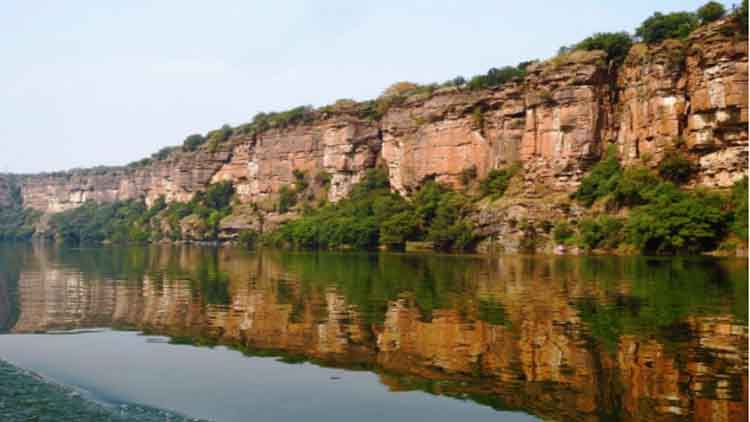
Chambal River, The rocks of Jawahar Sagar
Modest to the core, Zaidi says he has no idea how his pictures are different.
Today he has about 10,000 unique photographs to his credit; all these document the beauty and history of a region called Hadoti, Not only did he preserve the monuments and pristine beauty of a region but also made it a tourist and archeological attraction for people from around the world.
His pictures have also attracted the film industry to ithe region.
Hindi films like Chang, Matchis, Badrinath Ki Dulhania, Mardaani – 2 were shot in the location after being discovered by the movie makers through Zaidi’s pictures.
Line producer Subhash Soral says A H Zaidi’s is a reason behind filmmakers and TV serial makers using Kota’s scenic locations, archaeological sites, forts, palaces, forests, mountains, ponds, etc for their shoot. “Initially, I was would ask Zaidi Bhai to make albums for and I would show the same to producers in Mumbai and try to motivate them to shoot in Kota.”
However, over the years with Zaidi’s photos he has managed to arouse the interests of filmmakers in Kota. “Zaidi thinks differently; his vision is different and unique and that’s why I always use his photographs to promote a location in Kota.”
Tourism Officer Sandeep Srivastava says, “Zaidi's work is amazing. We assign him all the pictures of Heritage, Culture, and Wildlife; his data collection is unique.
“All the photos in my office are his works. Kota's Circuit House, Collector's Conference Hall, Railway Station, City In all the big hotels all have his pictures displayed.”
The Tourism department calls Zaidi an “icon of Kota.”
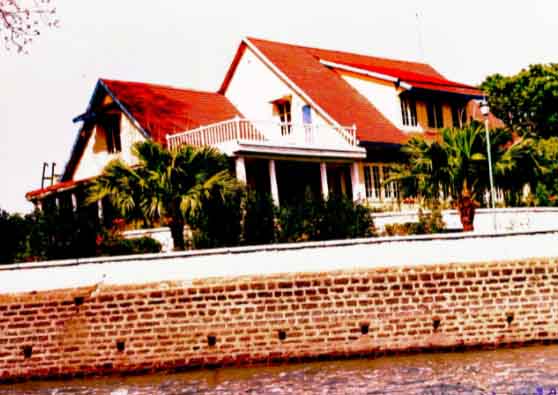
Rain Basera, the last image of the resort as captured by Zaidi before it got burnt
Zaidi’s photographs introduced the culture of Kota and Bundi that has remained confined to the palaces of Kings, to the people. The king's visit to the famous Kota Dussehra could only be seen by the guests inside the palace. Zaidi took it to the masses through his photographs.
The painting chambers of Bundi's palace that were limited to books were introduced to the people by Zaidi. On the way from Bundi to Kota and Jhalawar, the ruins scattered in the villages, towards the unclaimed historical wealth, attracted the attention of the government and the Archaeological Department only through his photographs.
And today many of his photographs have become rare and highly valued. The look and surroundings of many places, buildings, forts, and natural places has changed and these are unrecognizable. The information about their original form is found only from Zaidi’s collection.
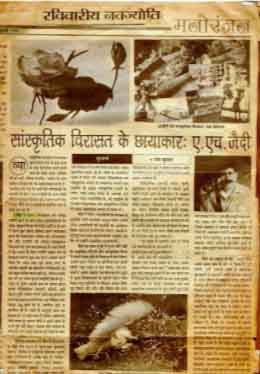
Story based on Zaidi's information and pictures in local newspaper
A small but yet scenic tourist resort of Jhalawar, Rain Basera made of wood, was destroyed in a fire in 2012. Its only memory is found in the pictures clicked by Zaidi. Sorsan was once the Godavan birds’ paradise. But due to hunting, their numbers decreased and 22 years ago only one was left, Zaidi has the picture of the last bird and his pictures of those days are a reminder of what humans have done to this natural birds' paradise.
No wonder, students of history, researchers, and officials of the Department of Archeology can’t do without Zaidi’s guidance. Zaidi says students from India and abroad regularly come to him. “I not only show them my photos, if needed, I also take them to the locations,” he says.
He is proud that after his pictures were published in newspapers and journals, many historical sites were taken over by the Archaeological Department for conservation. “There is an ancient temple in Barauli on Rawatbhata Road. I didn't even know about it. Once a national seminar on history was held in Kota and many speakers knew about it. I got the responsibility of taking them there.”
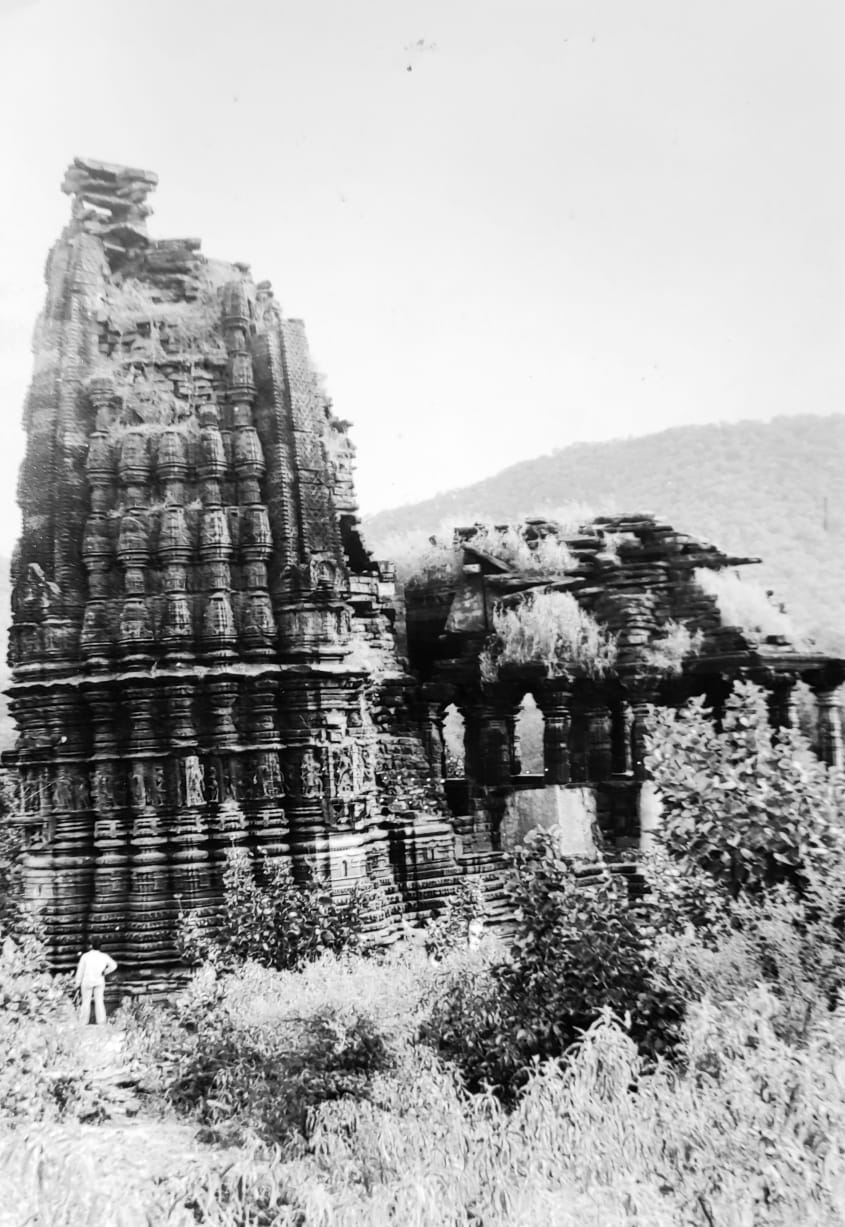
Bhand Devra Mandir, Baran
He saw the temple in ruins. Next, his pictures of the temple were published in newspapers making the Department of Archeology take it up for conservation. "Today it is a very beautiful tourist destination, “ says Zaidi.
Similarly, the Vilas Mandir in Baran has also been declared a protected monument. The temple has hundreds of miniature sculptures that the locals have vandalized and stolen. The government has since set up a small museum there.
The Gadgach temple in Atru village was also saved because of Zaidi's pictures. When he first took pictures of the Bhand Devra temple complex in Baran district, etc in 1975, only three of the five temples were left. The temple architecture resembles that of Khajuraho. Zaidi’s was the first photo of this temple.
Today, that picture adorns the secretariat of Baran district.
Once I asked Zaidi to show me a place that I had not seen. He took me to Kishore Sagar, located outside Kota city. I had visited the lake many times. Before me was a unique scene- hundreds of migratory birds were around the lake. Many people including students doing research, came along with Zaidi on the trip.
Zaidi says that the Hadoti region is full of water. Due to the Aravallis, there are many ponds there. The birds come in the rainy season filling the air with their lilting songs. It was simply a magical scene even for a local like me.
From the paintings in the palaces, one can make out that these birds have been coming from far-off destinations for more than 200 years. Those times were different; it was considered a natural and not a unique phenomenon. There was no publicity or awareness about it.
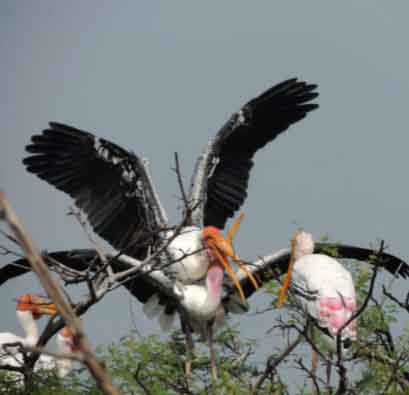
Painted Storks birds, Udpuria
Today, the place is full of migratory birds in this densely forested sanctuary. Zaidi said, there are a lot of local birds. I took their photos and got them printed in newspapers. The photo of the local bird Patent Stork of Udaipuria pond was published in the newspapers in 1995. This place is also the breeding center of this bird.”
Zaidi started learning photography in 1968. “I did my MA in painting; studied History in B.A. By the way, my father used to work in a private company. But he was fond of painting. He had two modest cameras. He used to bring home photographs of landscapes, paint the on canvass and frame them. In this way, since childhood, I became interested in both painting and photography,” Zaidi says.
It was difficult to manage a large family on the income of his father. So when it came to choosing a profession, he took to his father’s side profession. “My cousin was working in a photography studio.I also started sitting next to him as an intern. I bought a small Yashika camera and started clicking pictures whenever I went to Chambal, Bundi with friends. I visited Bundi often since my maternal grandmother lived there.”
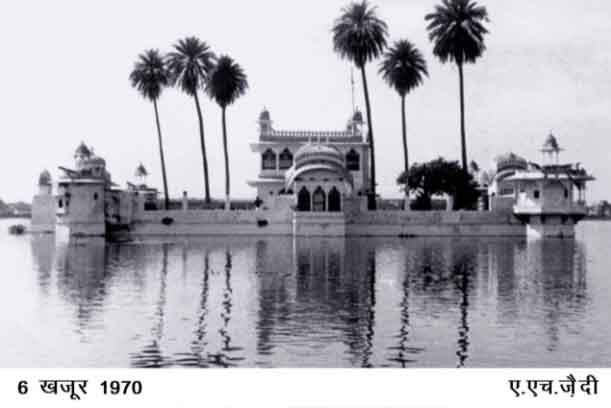
Six khajoor, Kota City's landmark
He took pictures of Umedganj, Alaniya, Abheda, Bardha, Jamuniya, Bhimlat, Ramgarh Talab/Reserve Forest and gave them for publishing to the local media. He bought a binocular and started observing the migratory birds. He would give pictures to the newspapers and also brief the reporter about his observations for a report.
This made him a name to reckon with and also increased the footfall to the bird sanctuary. Today, films or TV/web serials are shot around these ponds. All these are natural places as well as historical in the sense that there were summer palaces or hunting grounds of kings.
Zaidi was selected for a photographer’s job in the Zoology Department of Kota University. He would take students to natural locales and in his spare time, indulge in photography. He handed over his salary to his father for household expenses and to provide for himself he started doing commercial photography.
Soon, he had bought two more cameras. He would go out on a bicycle to photograph nature. Slowly, his horizons widened after he visited the same place many times. The places looked different in the morning, afternoon, and evening time or say afternoon. The beauty was not a static but dynamic thing; he would revisit the same place many times and recapture in all its moods, grandeur, and shades.
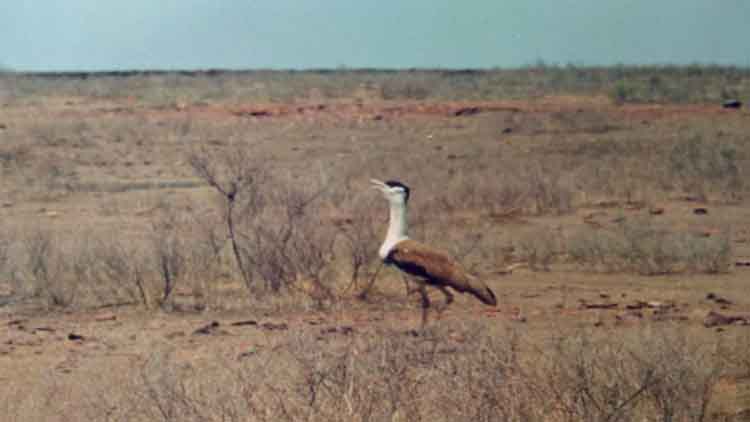
The last of Godavan bird of Sorsan captured by Zaidi
His work received appreciation and he felt encouraged. He started getting assignments from local institutions and also from outside. He invested in cameras, lenses, and other sophisticated equipment.
He told Awaz-the voice that the PRO of Kota Instrumentation Ramkumar Verma would send his photos along with his articles to the Swagatham magazine of the tourism department and publications in Germany. “I started making panoramas for them. Due to this, many foreigners were introduced to the natural and historical places of Hadoti. Kota or Bundi. After seeing my photos, many foreign tourists came here and took me along to see those places,” he said.
The newspapers and journals also started asking for his pictures. So, he started making slides for the government’s use. A slideshow on Kota’s history and traditions became a permanent fixture of the Dussehra Fair, Rajasthan Day, Tourism Diwas, etc. The slide show was also shown in schools and colleges.
For the first time, people got to see the Dussehra as it happened inside the palace through his slide show.
He received an award from the government for his work on heritage in 1984. He worked on a UNICEF project on Anganwadis, children's education, and other aspects of village life.
In 1995 INTACH (Indian National Trust for Architecture and Cultural Heritage) used his photographs for a show on 'Heritage of Hadoti'. “When the collector of Bundi, Madhukar Gupta, saw my collection, he made planned the Bundi festival and it was organised in 1996. It had an exhibition of my photos in an 80-foot pandal; slide shows were also held. Even in Souvenir, 28 out of 34 published photos were mine,” he says with pride.
A five-foot photo of Bundi Mahal was installed at the gate of the collector's office and it remained there for many years.
The Mayor, NGO or officials, approached him for photographs of Hadoti’s for showcasing its culture abroad. Today, there is a website on Hadoti, most of the pictures on it are Zaidi’s.
His pictures have made more than 200 slide shows in India, England, Germany, and France, possible. Besides Hadoti, his pictures have helped set up more than 200 exhibitions in Jaipur and Delhi.
Zaidi has been bestowed upon the biggest honour for his professional work by the Rajasthan government. Besides being awarded by NGOs, social groups, and local authorities, Zaidi has received awards from All India Tourism and Wildlife for his photo of black neck stroke’s nesting.
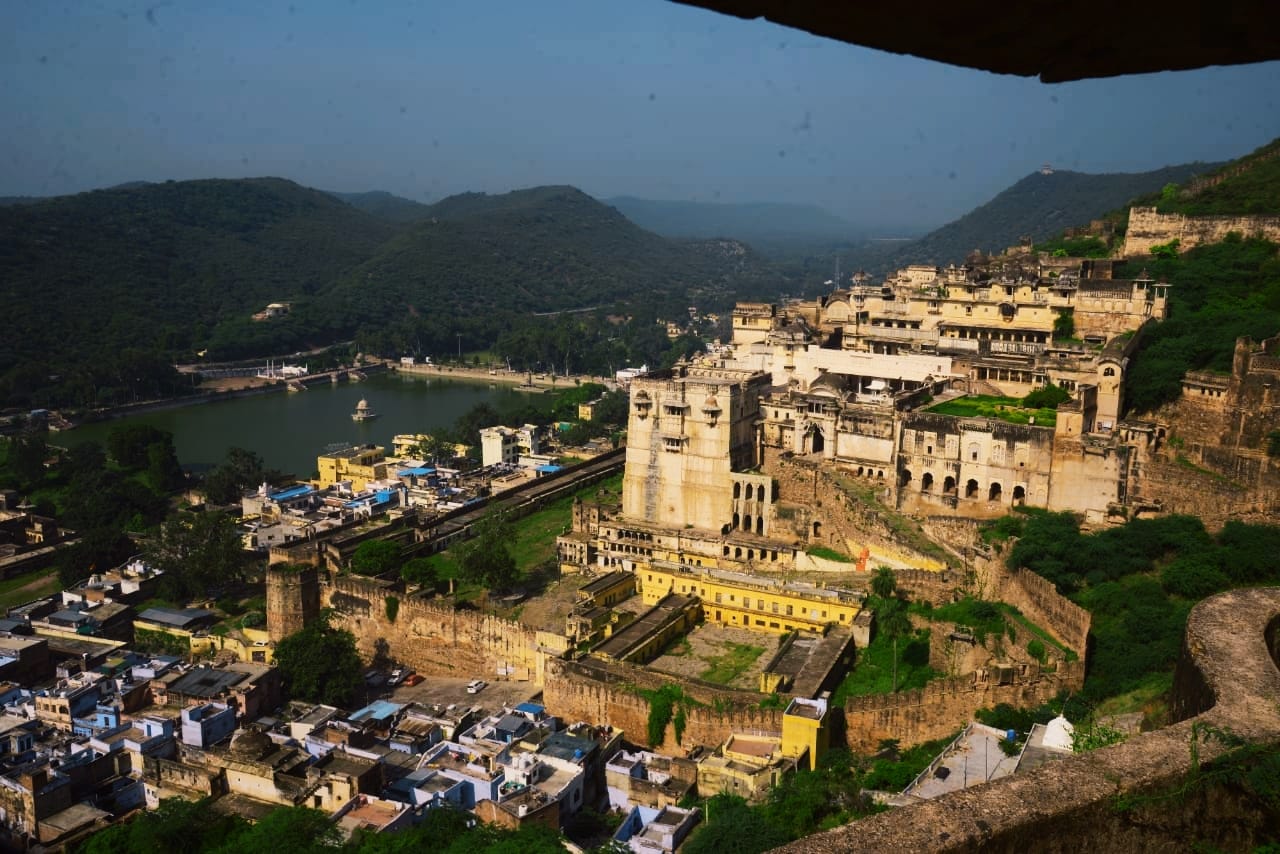
Tara Palace, Bundi
Zaidi says his accomplishment come from a reality that he didn’t treat photography as his business or a sorce of earning fame. It is his spiritual passion. He says, "To fulfill this passion, I paid less attention to my family.'
His wife Razia Zaidi, who is originally from karachi, says, 'Initially, I found it hard to understand why he picks up the camera and suddenly leaves home be it morning or evening. I would not know about his whereabouts for hours. Sometimes he would return home in the evening only.”
However, she says, though initially she felt bad about her husband’s ways but later when he explained her and she saw important people visiting him, Razia realized the importance of his work.
“For modeling pictures, they would have to take women models on their bikes to locations and his friends would tease me about them.” She had, however, learned to laugh about such things.
She gradually became fond of hosting Zaidi’s friends for Ramazan’s Iftar and also on other days. We all used to wait for the Karachi-style food of Razia bhabhi as she made not only meats but also vegetarian food. Her food would make people lick their fingers.
Zaidi became a member of the Bombay Natural Society to study wildlife. He learned the skill of identifying birds. The Hadoti Natural Society was established in Kota and he became its vice-president. When Dara Sanctuary has been converted into Mukundra Hill Tiger Reserve a few years ago, Zaidi was named to its tourism advisory committee.
Zaidi says, “I have the urge to learn; for example, if I saw a good photo in a magazine, I would study it and watch it through the lens of my camera.”
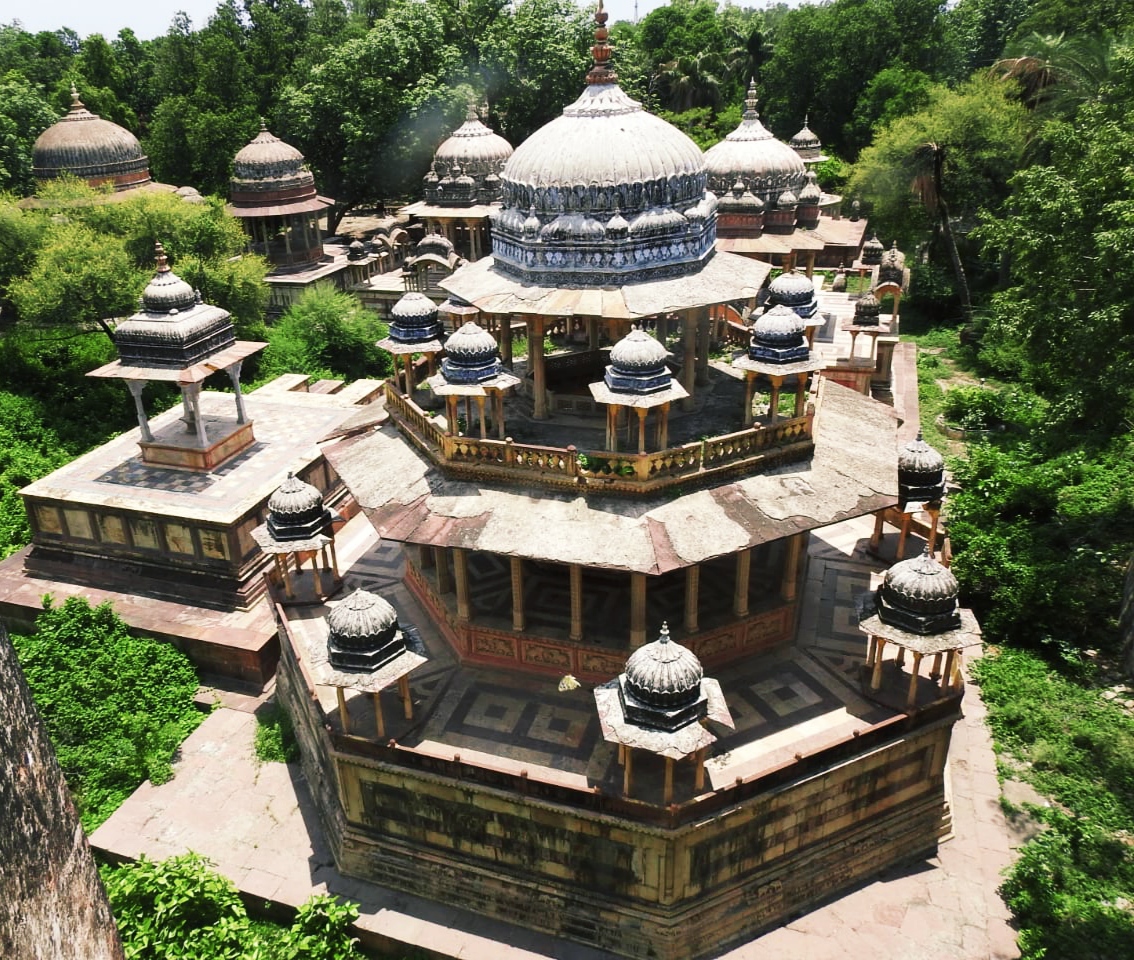
136 khambonwali Chattri, Sharbagh garden complex, Kota
He tried clicking pictures till he attained desired results. He has never taken a picture of less than four into twelve dimensions. He does his recce of the place first. “I have more than 30 cameras to work with. Even though very high-resolution cameras are now available inside the mobiles I insist on regular cameras for excellent results.”
Zaidi did not keep his skill to himself. Under the education program of Rajasthan Patrika, he taught the nuances of photography to more than 1,000 students. Most of the press photographers in Kota today are his disciples.
Opposite light is the special feature of his photography. One of his two sons is a photographer. He has his studio. 'He didn't get into heritage photography,' says Zaidi. “After all someone needs to make the money that goes into running a joint family,” he says.
